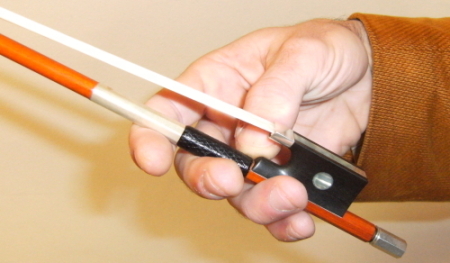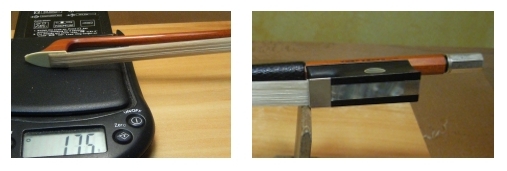CURVE AND BALANCEAs already announced in the previous post THE CURVE AND THE FORCE many musicians, even the cleverest ones, while trying a bow, sometimes even before playing with it, ask questions such as “Nice bow, but how much does it weight ??”. As already told, among many useful questions they could ask, they choose the most useless, because weight has nothing to do with force or mechanic. Furthermore no musician can feel the weight of a bow, he feels the weight on the point, i.e. the balance.
Speaking about balance, if we mean the weight on the point, it is clearly reductive. The test that you see in the pictures here below, allows to simulate the “weight sensation” that the musician receives from the bow while handling it. To carry out this test it is necessary to place the head on the scale plate (pic. # 1 ) while the frog has to be placed on a higher place, placing the support just after the ring (pic. # 2)
Picture 1 Picture 2 Carrying out this test we obtain value in grams that cannot be absolutely compared to the weight sensation or better, I would call it “the movement sensation” , to be more precise, and this is the sensation that the musician feels. It is nevertheless a good advice in particular when the musician is not a very expert one. In fact, the person making the bow doesn’t worry at all about this test because first of all it permits to know which is the weight sensation felt by the musician only in that particular position but the movement sensation of a bow changes sharply depending on its position. The bowmaker knows that the balance is a result of the curve, the stick thickness, the material density, the propagation speediness of the fibers and many other details a bow is composed of. If the hand-crafter can understand the material and use all these parameter in a harmonious way, the bow will be well balanced. Balance is the most ethereal of the parameters that have to be evaluated and it is measurable only by personal sensations. Some years ago I had the way to prove how balance cannot be measured. I brought two bows to a friend of mine that played violin. One bow was heavier than the other one, both on the head and as total weight. After having tested both of them very carefully, he tells me that he prefers the lighter one showing me the heaviest between the two of them. I said “ I am glad you liked it but that one is the heaviest, not the lightest”. He is an international concert player, as well as a renowned teacher in Italy and abroad, therefore he owns a strong technical knowledge, so his reply was a simple “it is not true”. Unbelievable enough I had to put both of them on the scale to show him that I was right so he could judge with his own eyes. The explanation of this misunderstanding has to be searched in the highest smoothness and natural movement of the heavier bow and in the belief that the weight could be the only important parameter. My friend, as many others like him, just confused weight with movement sensation. The heavier bow was so well balanced, so harmoniously done, that gave the sensation to disappear from the hand and my friend felt it at once, since he has a great talent. The mistake arose because he misjudged weight with energy. Here below I state a reference table for the bow weights, giving them on the point and as total weight. Violin bow :total weight from 58 g to 62g abt – weight at the point from 16,5g to 18g abt Viola bow :total weight from 68g to 72g abt – weight on the point from 20g to 22g abt Cello bow :total weight from 78g to 82g abt - weight at the point from 24g to 26g abt Double bassbows-French model: total weight from 130g to 136g abt – weight at the point from 29.5g to 31.5 g abt (P.S.: the weights for double bass bows were made as per our own model, as the parameter for this kind of bow have not been fixed by the French school, as did for the other models). So long Paolo.
|
   |







